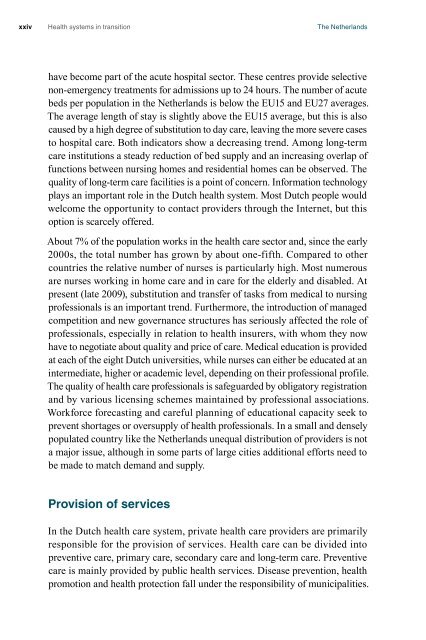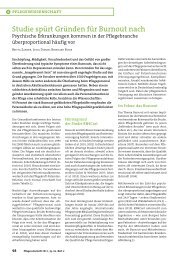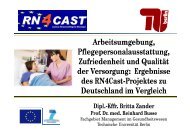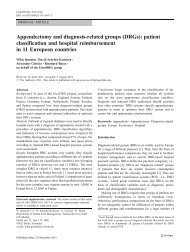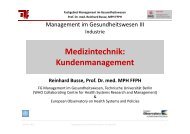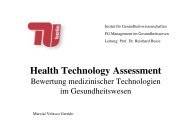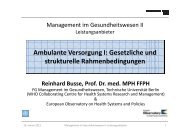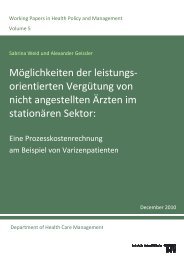The Netherlands: Health System Review 2010
The Netherlands: Health System Review 2010
The Netherlands: Health System Review 2010
Create successful ePaper yourself
Turn your PDF publications into a flip-book with our unique Google optimized e-Paper software.
xxiv<br />
<strong>Health</strong> systems in transition <strong>The</strong> <strong>Netherlands</strong><br />
have become part of the acute hospital sector. <strong>The</strong>se centres provide selective<br />
non-emergency treatments for admissions up to 24 hours. <strong>The</strong> number of acute<br />
beds per population in the <strong>Netherlands</strong> is below the EU15 and EU27 averages.<br />
<strong>The</strong> average length of stay is slightly above the EU15 average, but this is also<br />
caused by a high degree of substitution to day care, leaving the more severe cases<br />
to hospital care. Both indicators show a decreasing trend. Among long-term<br />
care institutions a steady reduction of bed supply and an increasing overlap of<br />
functions between nursing homes and residential homes can be observed. <strong>The</strong><br />
quality of long-term care facilities is a point of concern. Information technology<br />
plays an important role in the Dutch health system. Most Dutch people would<br />
welcome the opportunity to contact providers through the Internet, but this<br />
option is scarcely offered.<br />
About 7% of the population works in the health care sector and, since the early<br />
2000s, the total number has grown by about one-fifth. Compared to other<br />
countries the relative number of nurses is particularly high. Most numerous<br />
are nurses working in home care and in care for the elderly and disabled. At<br />
present (late 2009), substitution and transfer of tasks from medical to nursing<br />
professionals is an important trend. Furthermore, the introduction of managed<br />
competition and new governance structures has seriously affected the role of<br />
professionals, especially in relation to health insurers, with whom they now<br />
have to negotiate about quality and price of care. Medical education is provided<br />
at each of the eight Dutch universities, while nurses can either be educated at an<br />
intermediate, higher or academic level, depending on their professional profile.<br />
<strong>The</strong> quality of health care professionals is safeguarded by obligatory registration<br />
and by various licensing schemes maintained by professional associations.<br />
Workforce forecasting and careful planning of educational capacity seek to<br />
prevent shortages or oversupply of health professionals. In a small and densely<br />
populated country like the <strong>Netherlands</strong> unequal distribution of providers is not<br />
a major issue, although in some parts of large cities additional efforts need to<br />
be made to match demand and supply.<br />
Provision of services<br />
In the Dutch health care system, private health care providers are primarily<br />
responsible for the provision of services. <strong>Health</strong> care can be divided into<br />
preventive care, primary care, secondary care and long-term care. Preventive<br />
care is mainly provided by public health services. Disease prevention, health<br />
promotion and health protection fall under the responsibility of municipalities.


